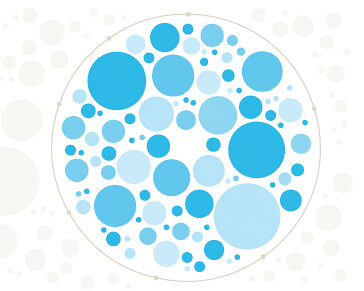
One of the books in my summer reading pile is Eli Pariser’s The Filter Bubble: What the Internet is Hiding From You. Last week, my Networked Nonprofit co-author Alison Fine recently interviewed the author on her monthly Chroncile of Philanthropy podcast. She helps us understand exactly what a filter bubble is – and why it is potentially a big problem for activists. Her thoughts:
It’s a great book, but the idea of filter bubbles is crushing for those of us who believe that an open web is a vital part of a democratic society. The filter bubble is the personalization of the web for users done by companies like Facebook and Google to sell us more stuff. They use enormous amounts of our own data to bring us searches and news feeds they think we want with ads specifically geared towards those interests. Here’s how Eli describes it in his book: “More and more, your computer monitor is a kind of one-way mirror, reflecting your own interest while algorithmic observers watch what you click.”
What I didn’t know, what floored me, was that they are only bringing us information in our searches and news feeds they think we want. It is not an open, unfiltered search for “environmental justice” it is a search based on my past searches and interests. Again, in Eli’s words, this means, “You can get stuck in a static, ever-narrowing version of yourself-an endless you-loop.” This is depressing news for advocates and their causes, which need to broaden their networks to new networks to be successful. Much of the network building that happens online is not even intentional, it’s the online serendipity that is similar to what happens when you meet someone online at the supermarket or sit next to them on an airplane. But the filter bubble reduces the opportunities for online serendipity, we just keep bumping into the people, organizations, ideas that we already know.
He also points out in the interview he explains that as the Internet is rewards being “likable,” he notes. He also points out that unpopular causes may not get reader’s attention. For example, a campaign about a push to reduce prison penalties in California to reduce the budget might not get a reader’s attention as a more “likeable” cause.
One question raised is how does a nonprofit working on issues that might not be popular find a way to rally activists?
It made me wonder how online activists and nonprofits might use some of online ads on Facebook (and possibly Google + if brand presence goes in that direction) which is a form of personalization on the web to broaden their networks and be open to serendipity? It takes having an organizational mindset that is open to experimentation.
In an odd moment of serendipity, I found this post from e-politics that included a case study on how Facebook ads defeated a Florida Ballot Initiative. The “Vote NO on 8” campaign sought to defeat a November 2010 ballot proposition that would have led to larger K-12 class sizes in Florida public schools. The campaign focused on the importance of small classes in children’s learning and teacher effectiveness.
The campaign had a very small budget and needed to maximize the effectiveness of its marketing to persuade voters to vote no on the proposition. The backers also knew at the outset that they wanted to find a new model for voter communication. The first goal of the Facebook Ads campaign was to use Facebook as a market research tool to hone the messages identified by a baseline poll specifically for each micro-audience of targeted voters in Florida and for each demographic group. The learnings from this market research would be used across all other media buys. The second goal was to saturate Facebook users in Florida with targeted messages in the month prior to the election. The third, and most important goal, was to measure the impact of the online ad program to assess its viability as a new model for voter persuasion.

The case study explains the different ways they tested messaging and visuals – and used the feedback loops to refine their messages. The results: they served up 75 million impressions and they won the initiative.
Some nonprofits have experimented with social advertising as part their communications strategy and Google AdWords. A while back I did a blog post about the Ocean Conservancy experiment with Facebook Ads. Recently, I also heard reports of nonprofits using Facebook ads as part of their page recruitment, promote offline events, and social fundraising campaigns.
All of these approaches take an organizational mindset that embraces experimentation. So a few best practices here for experiments that work for testing social platform ads or any other low-risk experiment in social media for that matter:
- Design experiments so they involve some incremental changes of existing work routines
- Design experiments so they are not a time suck
- Try as much as possible to avoid having experiments be “extra credit,” but a part of the work flow
- Articulate learning questions on the front end, identify metrics/data to collect to answer questions
- Spend time extracting lessons learned and design principles at the end
- Incorporate ‘rinse and repeat” of experiments over time
Has your organization experimented with online ads? How did you design your pilot? What did you learn?

Leave a Reply